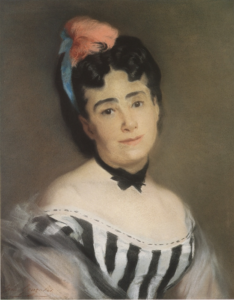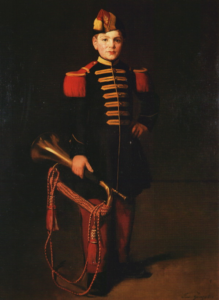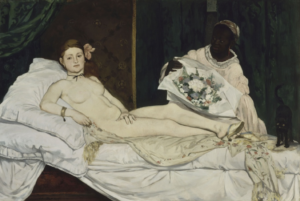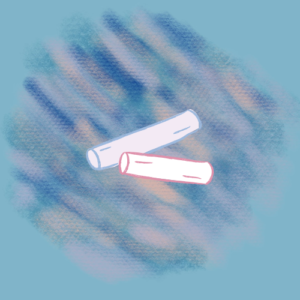
Figure 1. Eva Gonzalès, Portrait de Madame E.G.. 1869. Pastel on canvas. 61.5 x 51 cm. Private Collection.
Eva Gonzalès made her professional debut at the Paris Salon of 1870, exhibiting two works in pastel: La Passante (The Bystander, 1870) and Portrait de Madame E.G. (1869; Fig 1), along with an oil painting, L’Enfant de Troupe (The Boy Soldier, 1870; Fig 2). Over the course of her career, Gonzalès created a total of 124 works, 22 of which were pastel; 14 of those were shown at the Salon.[1] While works in pastel represent a small portion of her oeuvre, these works played an important role in her efforts to shape her public persona and, accordingly, in the critical reception of her art. In turning to pastel, Gonzalès utilized a medium long associated with stereotypically feminine attributes such as “delicacy,” and with female artists. Yet Gonzalès’s use of pastel was not influenced merely by conformity to the strict gender norms assigned to nineteenth-century female artists; it should also be understood as a calculated choice that contributed to her artistic self-fashioning. Thus, she successfully navigated gendered conventions while deploying the medium in bold, experimental ways in the 1870s and early 1880s.

Figure 2. Eva Gonzalès, L’Enfant de Troupe. 1870. Oil on canvas. 130 x 98 cm. Musée Gaston Rapin, Villeneuve-sur-Lot, France.
In this period, Gonzalès used pastel in a manner that increasingly aligned her art with that of the Impressionists. This allowed her to subtly establish her own artistic identity, independent from her one-time teacher Édouard Manet. Her association with Manet began in February 1869, when the two were introduced by their mutual acquaintance, painter Alfred Stevens. By that time, Gonzalès already had some artistic training under Charles Joshua Chaplin, a well-known society portraitist.[2] Gonzalès became Manet’s only formal pupil, and she continued to receive guidance from him throughout her career.[3] Like Manet, Gonzalès exhibited regularly at the Salon, and chose not to participate in the Impressionist exhibitions of 1874-1886. She did, however, show in other venues, including the 1874 “Salon des Refusés”; an 1882 exhibition staged in the offices of the periodical L’Art; the first-ever “Salon de Femmes,” which took place that same year; and at the Galerie Georges Petit, a commercial gallery, in 1883.[4] From this history, we can surmise that Gonzalès built her artistic reputation by striking a careful balance between participation in the mainstream art world and the adoption of an increasingly avant-garde, Impressionistic style.
Gonzalès’s relationships with Manet and other peers, both male and female, have often overshadowed her career, both during her lifetime and in scholarly discourse after her untimely death in 1883. Even feminist scholars at times foreground Manet’s art in ways that inadvertently promote him at her expense. This is true, for example, of Carol Grant’s 1994 dissertation on Gonzalès, which is one of very few texts to focus exclusively on the artist. Grant’s stated aim is to “provide new information and richer insight concerning the content of at least, her major work.”[5] At the same time, Grant frequently resorts to comparisons with Manet that can make Gonzalès’s work appear derivative—as when she argues that Gonzalès’s Une Loge aux Théâtre Italiens (1874; Fig. 3) is indebted to Manet’s Olympia (1856; Fig. 4) on the basis of the shared motif of a bouquet. Tamar Garb’s writing on Manet’s 1870 portrait of Gonzalès portrait falls into a related trap.[6] As Garb rightly notes, the portrait fails to portray Gonzalès as an accomplished artist in her own right. Details such as her white dress (which would be impractical to wear when painting) and the canvas on the easel in front of her (a creation of Manet’s) stress Gonzalès’s propriety and strip her of her identity as a painter. Instead, Garb argues, this painting functions as a manifesto declaring Manet’s own commitment to painterly realism. While this reading is convincing, it ultimately centers on Manet’s artistic choices, thereby depriving Gonzalès of agency over her own image as an artist.

Figure 3. Eva Gonzalès, Une Loge aux Théâtre des Italiens. 1874. Oil on canvas. 98 x 130 cm. Musée d’Orsay, Paris, France.
Gonzalès is also frequently compared with other female artists in the Impressionist orbit, such as Mary Cassatt and Berthe Morisot, simply by virtue of their shared gender. Gonzalès has been included in exhibitions such as “Les Femmes Impressionnistes” at the Musée Marmottan in 1993 and “Women Artists in Paris: 1850-1900” at the Clark Institute in 2018, among others. While such comparisons can be somewhat illuminating, they flatten the complexities surrounding Gonzalès’s relationship to the Impressionist group, including the fact that she apparently chose not to participate in their exhibitions. Gonzalès’s inclusion solely on the basis of gender thus once again obscures her individuality as an artist and the particular ways she navigated her professional career.
Albert Boime alone goes beyond the correlation of Gonzalès’s interests with those of her artist peers. Boime focuses on a review of Gonzalès’s Une Loge aux Théâtre des Italiens by the nineteenth-century French feminist critic Maria Deraimes. Through a close reading, he argues that this politically charged review not only promotes Deraimes’ own intellect, but also Gonzalès’s, by highlighting the artist’s strategic

Figure 4. Edouard Manet. Olympia.1863. Oil on canvas. 130 x 190 cm. Musee d’Orsay, Paris, France
engagement with the subject matter. As Boime notes, Deraismes called the woman in the theater box “highly intelligent and independent, able to respond to the music with a depth of feeling and appreciation foreign to her male partner.”[7] The agency that Desraimes attributes to this figure contrasts with contemporaneous works on similar subjects by Auguste Renoir and Mary Cassatt, in which the female figure does not project the same degree of intelligence and autonomy. Deraismes praises Gonzalès’s creativity and commitment to her profession, stating that the artist “has the wisdom to grasp that youth and beauty are transient gifts, while knowledge and talent are imperishable goods.”[8] While a useful corrective to the typical view of Gonzalès, this narrowly-focused essay isolates Gonzalès somewhat from the broader context of the Parisian art world.
My aim in this capstone is to focus on Gonzalès’s use of pastels in order to illuminate the way in which she navigated both the opportunities and the limitations she faced as a professional woman artist in the 1870s and 80s. In light of the relative lack of secondary sources on Gonzalès, and the absence of a catalogue raisonné, I have concentrated my research on primary sources, particularly critical reviews, as well as providing my own formal analyses of her works in pastel. Together with a history of pastel and its reception, these approaches can elucidate her strategies of professional self-presentation. It is my hope that this capstone can make Gonzalès’s work more visible to art historians and the general public, and thereby inspire further work on this important artist.
- Marie-Caroline Sainsaulieu and Jacques de Mons. Eva Gonzalès: 1849-1883: Étude critique et catalogue raisonné. (Paris: Bibliotheque Nationale: 1990), n.p.
- Delia Gaze. Dictionary of Women Artists. (Chicago: Fitzroy-Dearborne: 1997), 596-599.
- “Edouard Manet Eva Gonzalès” National Gallery, accessed February 12, 2021, https://www.nationalgallery.org.uk/paintings/edouard-manet-eva-gonzales
- Russell T Clement, Annick Houze, Christiane Erbolato-Ramsey. The Women Impressionists: A Sourcebook (Santa Barbara: Westport, 2000), 165.
- Carol Jane Grant, “Eva Gonzales (1849-1883): An Examination of the Artist’s Style and Subject Matter. (Volumes I and II).” (Ph.D. diss., The Ohio State University, 1994), 26.
- Tamar Garb, The Painted Face: Portraits of Women in France, 1814-1914. (New Haven: Yale University Press, 2007), 68.
- Albert Boime, “Maria Deraismes and Eva Gonzalès: A Feminist Critique of ‘Une Loge Aux Théâtre Des Italiens.’” Woman’s Art Journal 15, no. 2 (1994): 35.
- Boime, 36.
